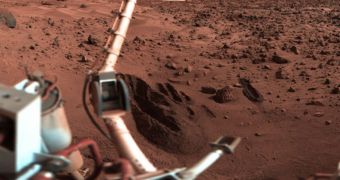In a study that is bound to reignite the decades-old debate about whether life existed on the Red Planet in the distant past, a team of experts proposes that samples collected by the NASA Viking Mars Lander indeed contained organic molecules.
Over the years, a number of investigations were conducted on these sample. Each of them came p with a slightly different result, and researchers were divided into two main camps – one which held that the samples contain organic molecules and another that argued positive results were an error.
The missions in questioned were conducted back in the 1970s, when two spacecraft landed on the surface of the Red Planet, and used robotic arms to scoop up dust samples from the Martian surface.
These sample were then analyzed using a variety of chemical agents, so as to determine whether organic molecules were included within. This class of molecules is absolutely essential for the development of carbon-based life as we know it.
During the studies they conducted on the collected samples, the Viking landers discovered few things of interest. Most appealing for further investigations were two peculiar chlorine compounds.
At the time however, scientists were more likely to attribute their existence to contamination from cleaning fluids that occurred inside the landers. In other words, they did not believe the compounds were actually collected from our neighboring planet's surface.
But the new research shows that Martian soils most likely contain interesting molecules that could underlie life. It also states that these molecules may have been destroyed during the Viking analysis.
“This result is saying that there are organic molecules on Mars. It doesn't say anything about life now, or life in the past,” explains scientist Chris McKay, quoted by Space.
“But it does open up the possibility of searching for organic molecules produced by life, and that's very exciting,” he adds. McKay holds an appointment as a research scientist at the NASA Ames Research Center in Moffett Field, California.
He is also the coauthor of the new study, which is detailed in the December 2010 issue of the esteemed Journal of Geophysical Research – Planets.
“The simplest, most reasonable explanation of the Viking results is that there were organics in the soil, and they were consumed by the perchlorate. I think it's pretty convincing,” the expert explains.
It will now be the task of the NASA Mars Science Laboratory (MSL) – the American space agency;s next mission to the surface of the Red planet – to search for signs of past life on Mars.
The rover will feature a suite of scientific instruments that will allow it to conduct a series of advanced investigations of soils and the chemical compounds they contain.

 14 DAY TRIAL //
14 DAY TRIAL //